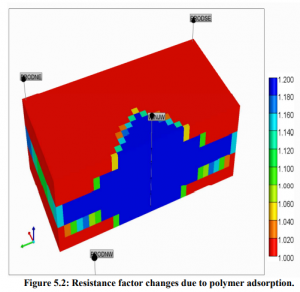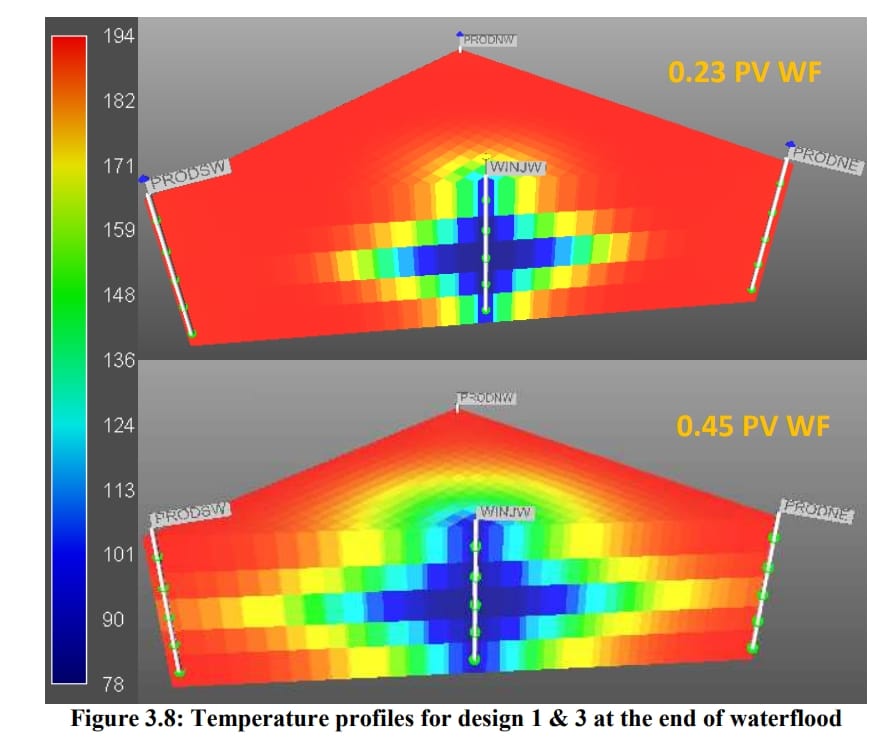SIMULATION STUDY FOR IMPROVING SEAWATER POLYMER FLOOD PERFORMANCE IN STRATIFIED HIGH TEMPERATURE RESERVOIRS
本文研究了剪切变稀、热变稀以及聚合物/海水溶液降解对分层储层中油回收性能的影响,并在不同温度条件下进行了研究。同时,研究了支持聚合物驱油的措施,如水力封隔和深度剖面控制,以评估它们在恶劣储层条件下的能力。通过流变仪测量了聚合物/海水溶液的热变稀和剪切变稀特性,并与已发表的数据进行了比较。从文献综述中总结了聚合物的降解和吸附特性,以及凝胶反应和抗性特性,为模拟生成了合理的参数。
模拟结果表明,聚合物的热变稀对最终油回收影响较小。另一个与温度相关的属性,聚合物热降解,明显受温度影响,导致最终油回收不同程度地减少。水力封隔和深度剖面控制都可以改善水驱效果。然而,如果应用聚合物驱油,深度剖面控制将更有效,并且在低注入温度下进行深度剖面控制和聚合物驱油的组合实现了最佳的恢复性能。
CMG软件的应用情况
在本研究中,CMG_STARS模拟器被用于模拟研究,包括质量守恒方程、边界条件、聚合物属性建模、相对渗透率模型、凝胶建模以及热参数等。CMG_STARS是一个三相多组分热和蒸汽附加模拟器,支持二维和三维配置,并能够处理包括聚合物驱油在内的多种驱油方法。模拟器能够与实验室核心驱油数据进行历史匹配,并且与实验结果达成很好的一致性。



Abstract
Polymer flood has achieved technical and commercial success, especially for its large-scale application in the Daqing oilfield in China. However, previous field tests indicated polymer flood was not economically successful for high temperature reservoirs when injected with high salinity, high hardness water. Novel thermal and salinity[1]resistance polymers have been developed, and their properties are tested via comprehensive lab experiments, which encourage further development of polymer flooding in high-temperature and high-salinity reservoirs.
To achieve a promising recovery effect, numerical simulation, including all significant physicochemical phenomena, must be carried out before field implementation to realize the reservoir response to polymer. An optimized recovery design, which minimizes costs and increases the process efficiency, should be proposed for reservoir models representing real harsh conditions including severe heterogeneity.
In this work, the effects of shear thinning, thermal thinning, degradation of polymer/seawater solution to oil recovery performance in stratified reservoir are studied in various temperature conditions. Also supporting measures for polymer flood, such as mechanical water shutoff and in-depth profile control, are studied to evaluate their ability in harsh reservoir conditions. Thermal thinning and shear thinning properties of polymer/seawater solution were measured by a rheometer, and compared with published data. Degradation and adsorption properties of the polymers, as well as the gelation reaction and resistance properties of the gel were summarized from literature review generating reasonable parameters for simulation.
Simulation results indicate that thermal thinning of polymers has a marginal effect on the final oil recovery. Another property related to temperature; polymer thermal degradation, is obviously influenced by temperature, leading to decrease of the final oil recovery to different extent. Both water shutoff and in-depth profile control can improve waterflood. However deep profile control will be more efficient if polymer flood is applied, and the combination of in-depth profile control and polymer flood carried out with low injection temperature achieve the best recovery performance.
作者单位
作者单位为德克萨斯A&M大学研究生与专业研究办公室(Office of Graduate and Professional Studies of Texas A&M University)。

